It happened today - March 20, 2016
 You can’t go back to Constantinople. Or ancient Rome. But people used to think there were lessons there including, even, the brief reign of Maximinus Thrax. Whoever he was.
You can’t go back to Constantinople. Or ancient Rome. But people used to think there were lessons there including, even, the brief reign of Maximinus Thrax. Whoever he was.
This is a genuine question. Thrax, the first “foreigner”, meaning barbarian, to become Emperor, on March 21 235, was clearly not from the Roman elite. Rather, he was a soldier of obscure peasant origins, one of a number of “barracks emperors” who fought and murdered their way to the throne only to be removed the same way. Thrax himself died during a Senatorial revolt in 238, and his reign, such as it was, is generally held to begin the “Crisis of the Third Century” also known as “Military Anarchy” (that can’t be good) in which 26 men claimed the imperial purple with sufficient plausibility to be recognized by the Senate in fifty years, and the Empire split into three hostile states.
Thrax himself is described as the product of a Gothic father and an Alanic mother by a history, the “Augustan”, that nobody believes anyway. So his identity is sort of a “maxi-minus” problem (a little joke for mathematicians there). And again his reign mattered far less for who he was or what he did than for what he ushered it.
What I find remarkable about the whole business is that after 50 years of apparently fatal turmoil, the anarchy was ushered out again. With the accession of Aurelian in 270, and the reforms of Diocletian in 284, the Empire rebounded. It is a tribute to its underlying dynamic strength that it could endure such a process.
I know, I know. It eventually folded up in the 5th century, although in a very real sense it never fell and we still live in it today. The West, with its liberty under law, its Christianity, and its sense of the value of the individual, is distinctly Roman, with important improvements most notably in functioning representative institutions. If you want to know whether a country is decent to live in, the fastest test is whether it is part of the lands the Romans ruled or places settled from those lands, excepting those torn away from this patrimony most notably by Islam.
Following the “Crisis of the Third Century” and the restoration of sensible order, you get names we have once again heard of, including Diocletian and of course Constantine under whom, it was once generally known, Christianity became the official religion of the Empire, having conquered from within and below rather than above and without. Also Valentinian I, the last emperor whose reign was so successful as to recall the glory days of emperors from Augustus to Hadrian or Septimius Severus and obscure the long period of crisis between the two.
Ultimately Rome did fall formally in the West, and after a very long decline its very different Eastern branch bought it in 1453 leaving a far less solid legacy. But it took a lot of ruin to do it in after many remarkable centuries of solid achievements as well as idiotic politics, intrigues that put soap operas to shame and realpolitik in foreign policy that did sometimes forget elementary decency but also kept the genuine barbarians at bay for many long years and often persuaded them by its example to abandon barbarism.
So robust was Rome that even a half-century-long parade of characters like Maximinus Thrax couldn’t manage to stink the place out all that badly. Not a claim most empires, or political organizations of any sort, can make.